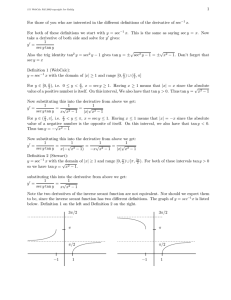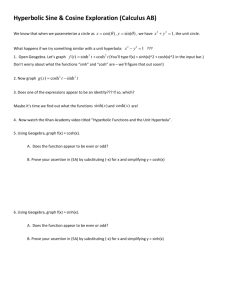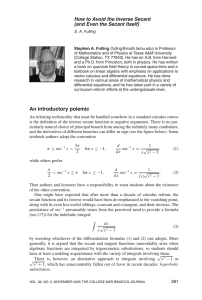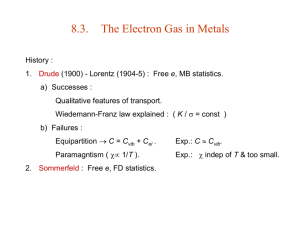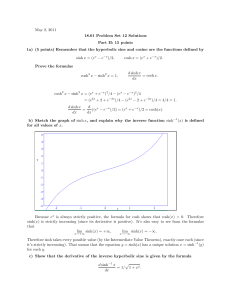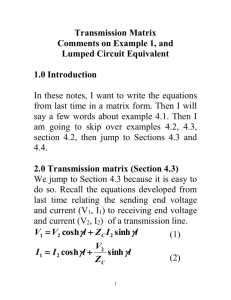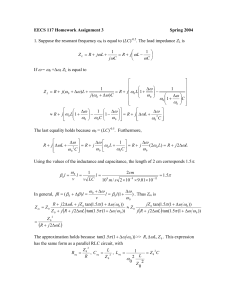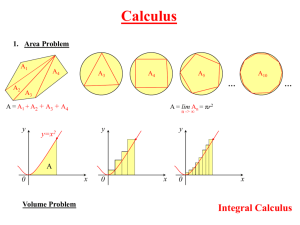Solutions
advertisement
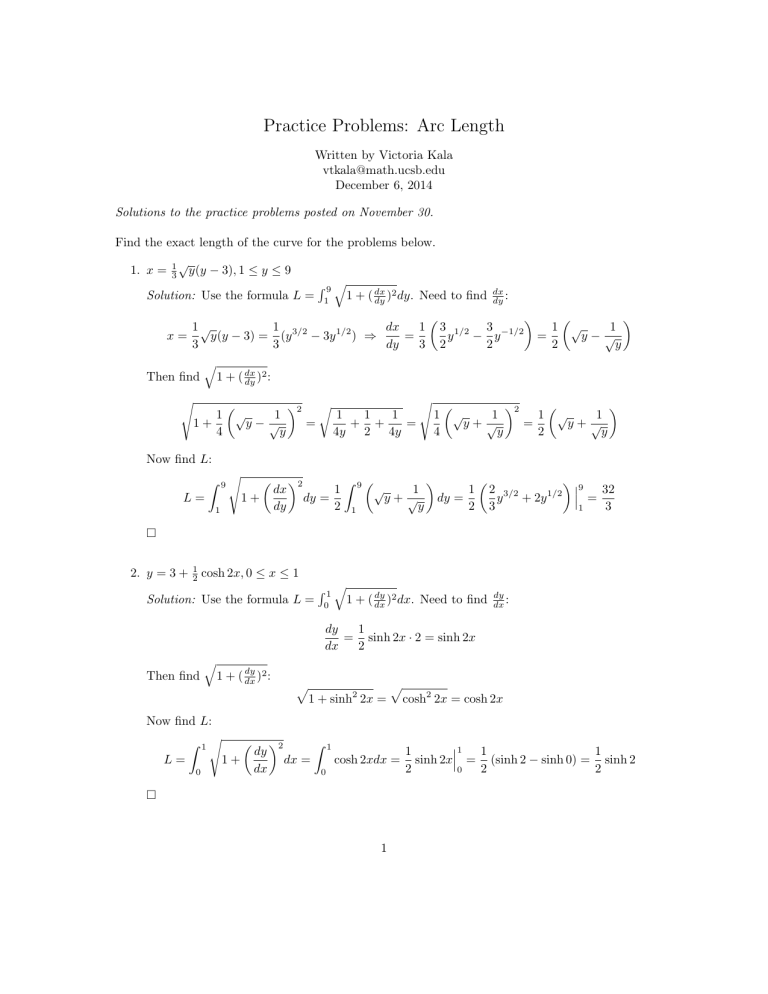
Practice Problems: Arc Length Written by Victoria Kala vtkala@math.ucsb.edu December 6, 2014 Solutions to the practice problems posted on November 30. Find the exact length of the curve for the problems below. 1. x = 1√ 3 y(y − 3), 1 ≤ y ≤ 9 Solution: Use the formula L = x= R9q 1 2 1 + ( dx dy ) dy. Need to find 1√ 1 dx 1 y(y − 3) = (y 3/2 − 3y 1/2 ) ⇒ = 3 3 dy 3 Then find s dx dy : 3 1/2 3 −1/2 y − y 2 2 = 1 2 √ 1 y− √ y q 2 1 + ( dx dy ) : 1 1+ 4 √ 1 y− √ y 2 2 r = 1 1 1 + + = 4y 2 4y s 2 1 √ 1 1 √ 1 y+ √ = y+ √ 4 y 2 y Now find L: Z L= 9 s 1+ 1 dx dy 1 dy = 2 Z 1 9 √ 1 y+ √ y 1 dy = 2 2 3/2 y + 2y 1/2 3 9 = 1 32 3 2. y = 3 + 1 2 cosh 2x, 0 ≤ x ≤ 1 Solution: Use the formula L = R1q 0 dy 2 1 + ( dx ) dx. Need to find dy dx : dy 1 = sinh 2x · 2 = sinh 2x dx 2 Then find q dy 2 1 + ( dx ) : p 1 + sinh2 2x = p cosh2 2x = cosh 2x Now find L: s 2 Z 1 Z 1 dy 1 L= 1+ dx = cosh 2xdx = sinh 2x dx 2 0 0 1 1 = 0 1 1 (sinh 2 − sinh 0) = sinh 2 2 2 3. y = ln(1 − x2 ), 0 ≤ x ≤ 1 2 Solution: Use the formula L = R 1/2 q 0 dy 2 1 + ( dx ) dx. Need to find dy dx : dy −2x 1 · −2x = = dx 1 − x2 1 − x2 Then find q dy 2 1 + ( dx ) : s 4x2 = 1+ (1 − x2 )2 s (1 − x2 )2 + 4x2 = (1 − x2 )2 s 1 + 2x2 + x4 = (1 − x2 )2 s 1 + x2 (1 + x2 )2 = 2 2 (1 − x ) 1 − x2 Now find L: Z 1/2 r Z 1/2 Z 1/2 Z 1/2 dy 2 2 2 1 + x2 L= 1 + ( ) dx = dx = −1 + dx = −1 − 2 dx dx 1 − x2 1 − x2 x −1 0 0 0 0 We need to use partial fractions to integrate 2 x2 −1 . x2 − 1 factors into (x − 1)(x + 1): 2 A B = + (x − 1)(x + 1) x−1 x+1 2 = A(x + 1) + B(x − 1) ⇒ 2 = (A + B)x + A − B ( A+B =0 We get the system of equations . Solving this system yields the solution A = A−B =2 1, B = −1. So then Z 1/2 Z 1/2 1/2 1 2 1 L= dx = + dx = −x−ln |x−1|+ln |x+1| −1 − 2 −1 − x −1 x−1 x+1 0 0 0 1 1 3 1 = − − ln + ln = − + ln 3 2 2 2 2 4. y = 1 − e−x , 0 ≤ x ≤ 2 Solution: Use the formula L = R2q 0 dy 2 1 + ( dx ) dx. Need to find dy dx : dy = e−x dx Then find q dy 2 1 + ( dx ) : p Now find L: Z L= 0 2 1 + (e−x )2 r dy 1 + ( )2 dx = dx 2 Z 0 2 p 1 + (e−x )2 dx Let u = e−x . Then du = −e−x dx ⇒ −ex du = dx ⇒ − u1 du = dx. When x = 0, u = 1. When x = 2, u = e−2 : Z e−2 p 1 1 + u2 du − u 1 Need to use trig substitution. Let u = tan θ, then du = sec2 θdθ (we won’t change the bounds on this one): Z p Z p Z Z 1 1 (1 + tan2 θ) sec θ sec3 θ 1 + u2 du = 1 + tan2 θ sec2 θdθ = dθ = dθ u tan θ tan θ tan θ Z Z sec θ = dθ = (sec θ tan θ + csc θ) dθ = sec θ + ln | csc θ − cot θ| sec θ tan θ + tan θ √ p 1 + u2 − 1 2 = 1 + u + ln u So then Z − 1 e−2 p p 1 1 + u2 du = − 1 + u2 − ln u √ √ 1 + u2 − 1 u e−2 1 √ √ 1 + e−4 − 1 − − 2 − ln 2 − 1 −2 e p p √ √ = − 1 + e−4 − ln( 1 + e−4 − 1) + ln e−2 + 2 + ln( 2 − 1) p p √ √ = − 1 + e−4 − ln( 1 + e−4 − 1) − 2 + 2 + ln( 2 − 1) p = − 1 + e−4 − ln 3
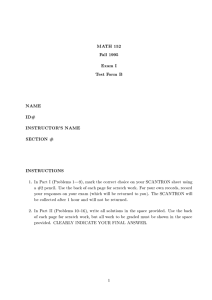


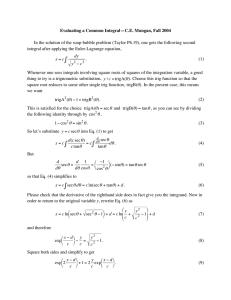
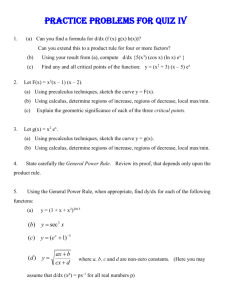

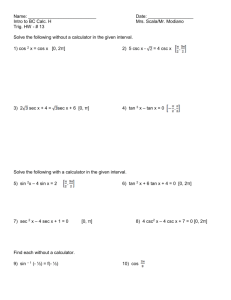
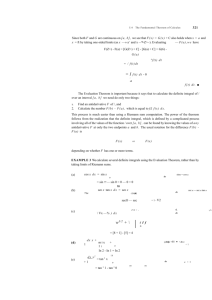

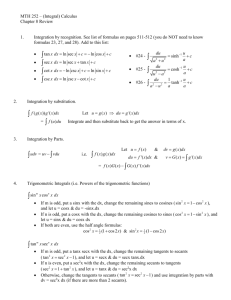
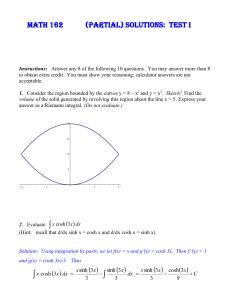


![1S3 (Timoney) Tutorial/Exercise sheet 9 Name: [Tutorials April 2 – 13, 2007]](http://s2.studylib.net/store/data/010571887_1-77de9ea88fb9efbd3fc69b51cb19b535-300x300.png)
